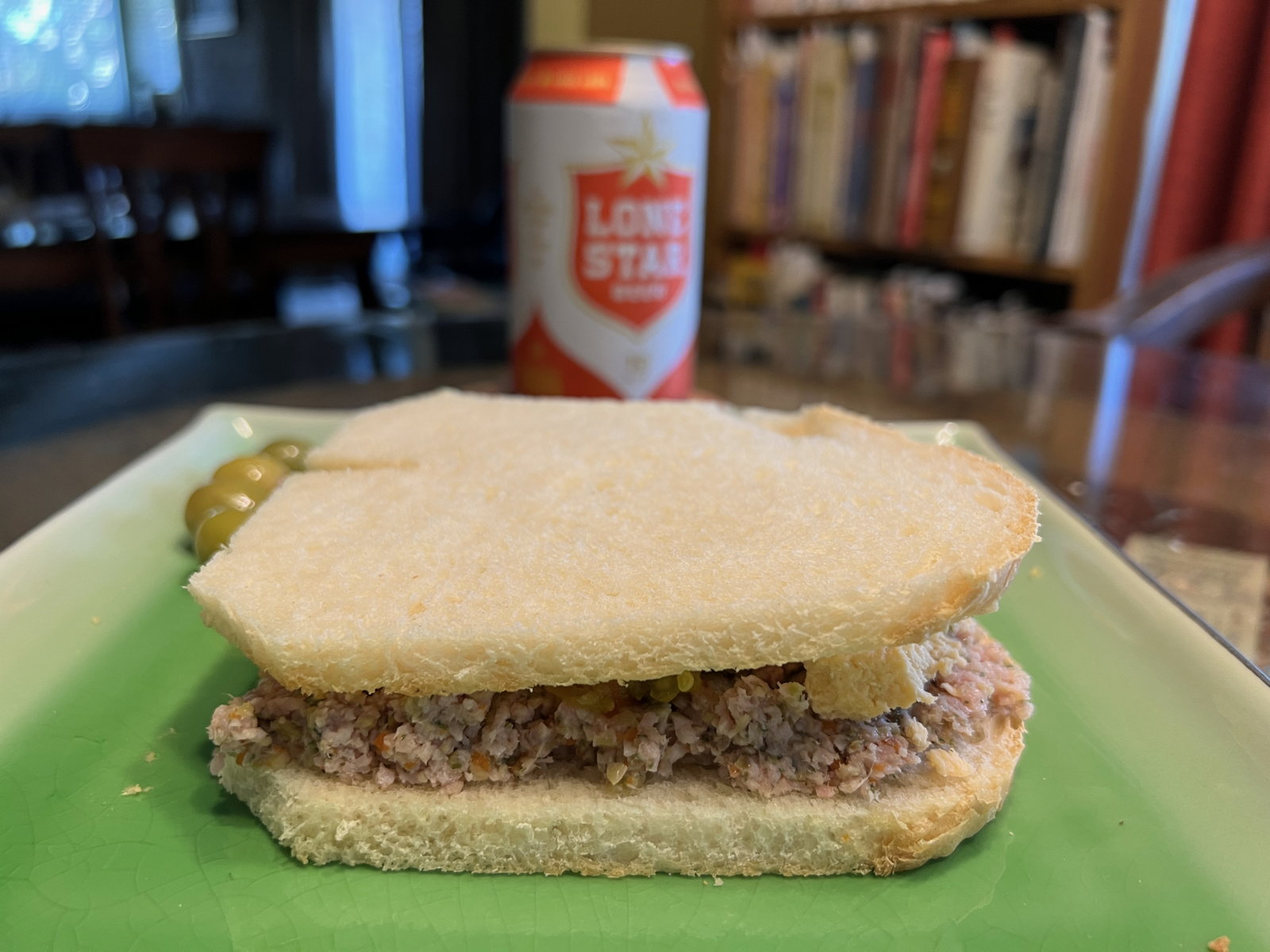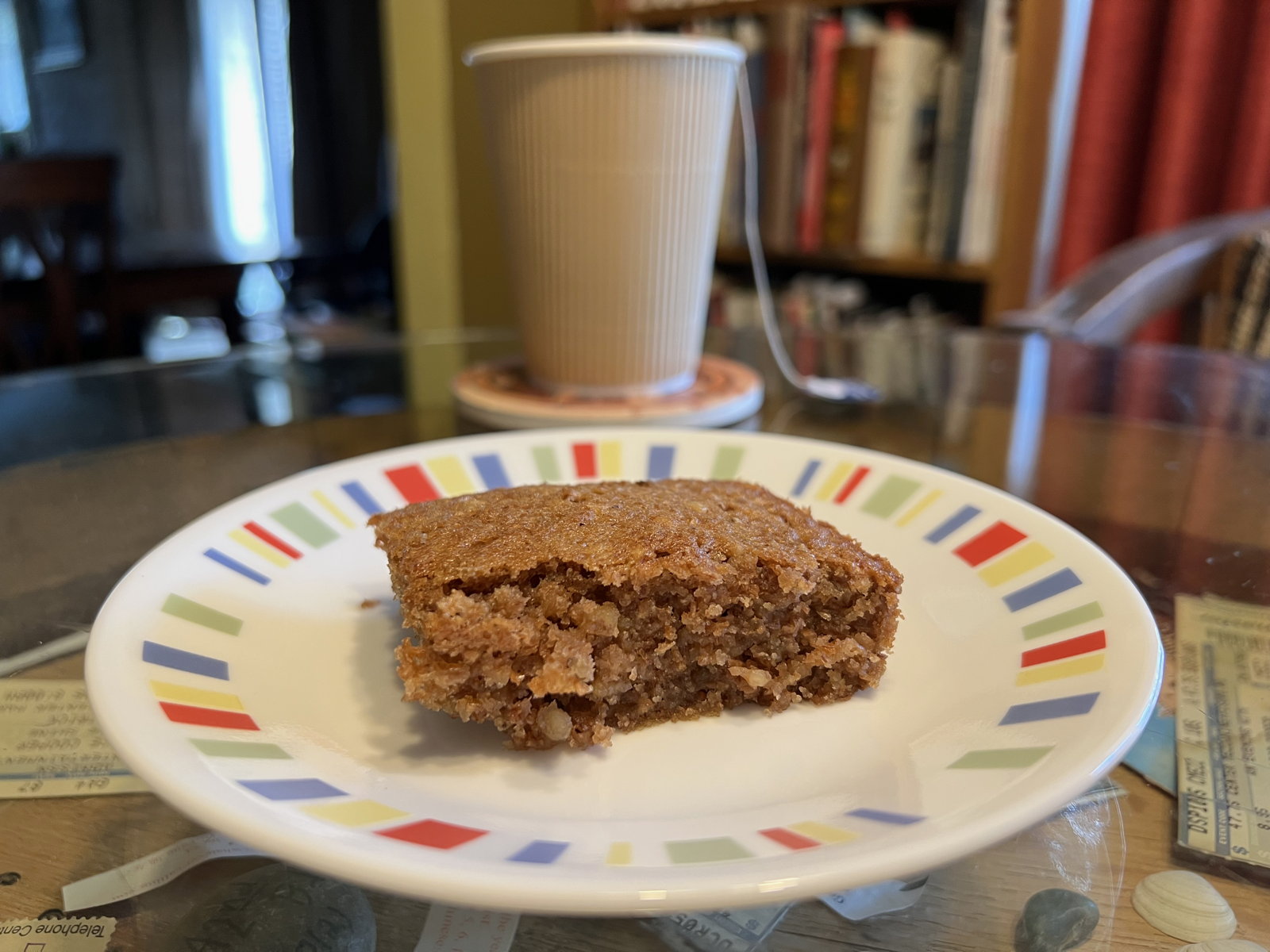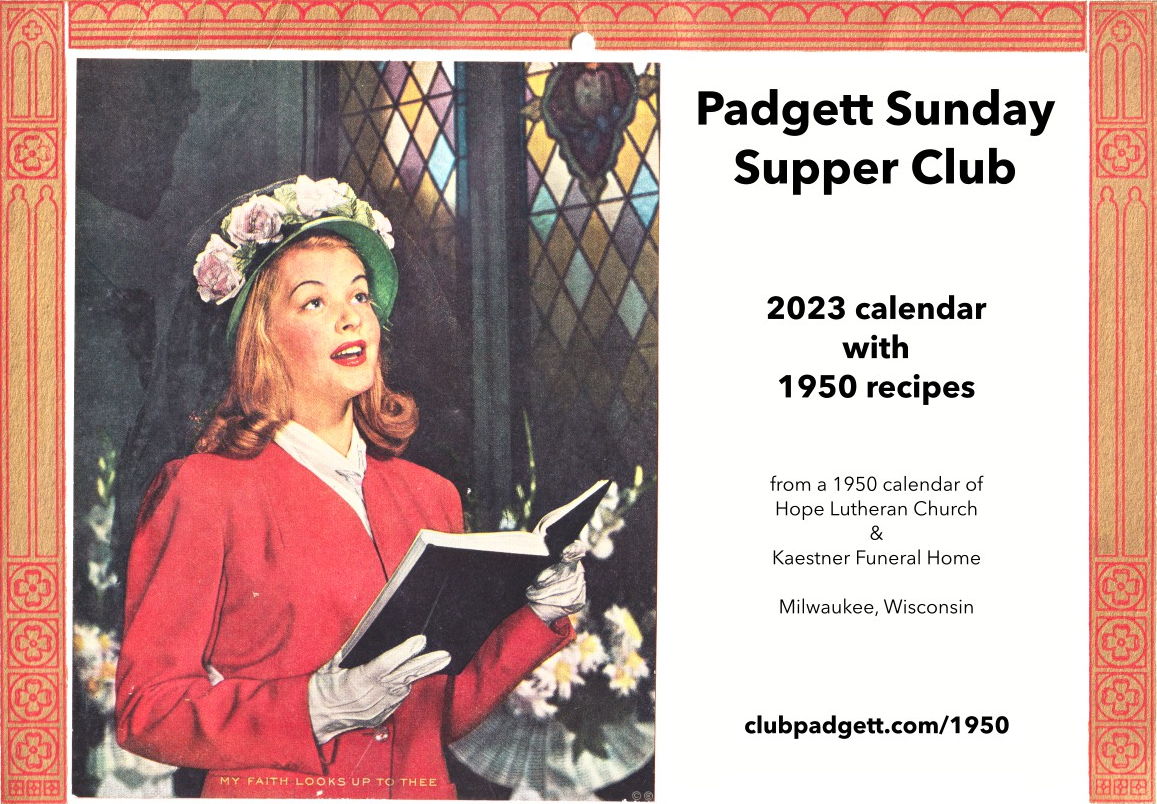A 1950 recipe calendar for 2023
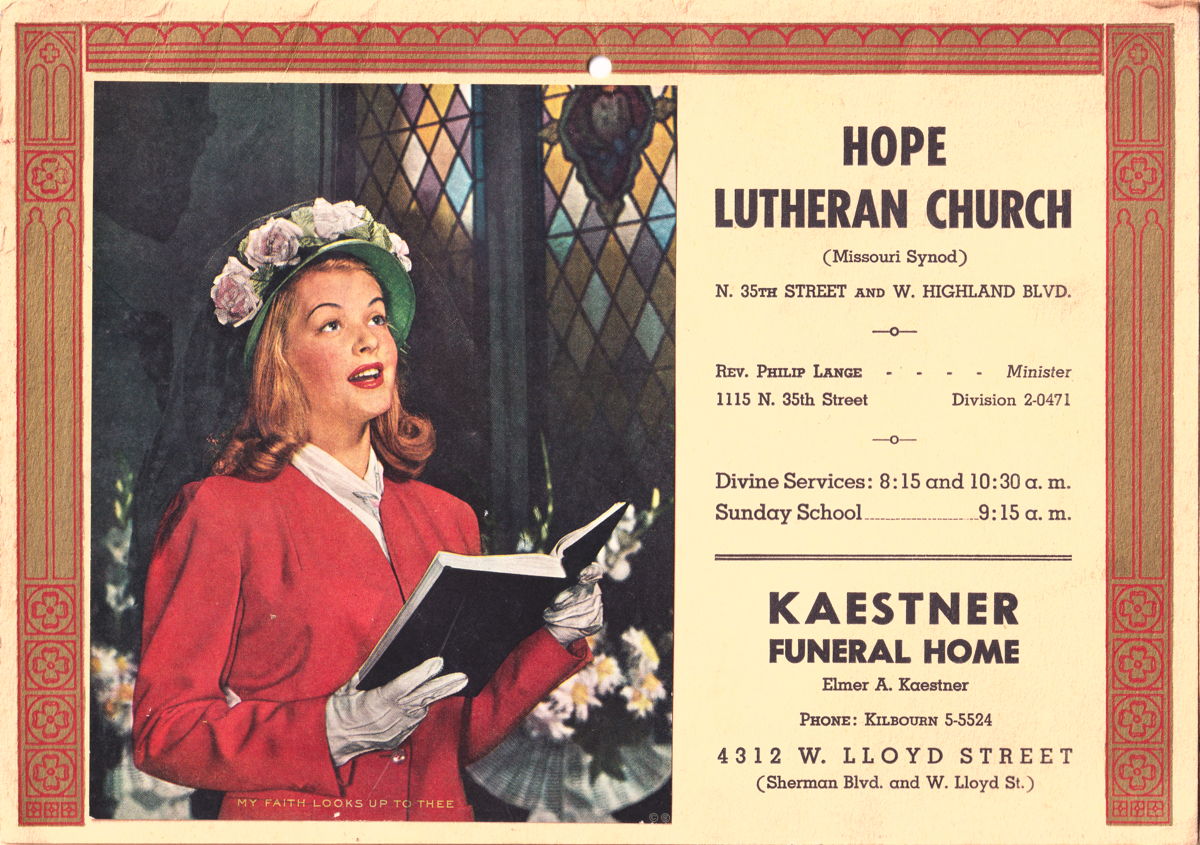
If you have any 1950 calendars lying around, you can use them in 2023—or you can use this wonderful old collection of recipes tied to the seasons!
Old cookbooks are not alone among the ephemera that often raise more questions than answers. Old calendars, with their strange holidays and even stranger assumptions about how you use them are also often like peering into a different country. But what about old calendars that are also cookbooks?
On the same online group that produced the wonderful Deplorable Gourmet—a few months before our Texas meetup—a friend posted the enigmatic (and always exciting) words “I found a cool cookbook for you. I’ll bring it to the meet.”
It turned out not to be a cookbook, but a calendar, a 1950 calendar from Hope Lutheran Church of Milwaukee, Wisconsin. It took me slightly longer to track down where they were than it should have because while they provided their address on the calendar, they did not include either the town or the state where the address was located. This was well before zip codes, too, and the phone numbers are all five digits with a word in front of them, that is, Division 2-0471 and Kilbourn 5-5524.
That Hope Lutheran is part of the “Missouri Synod” sent me up the entirely wrong tree, as there is in fact a Hope Lutheran just outside of St. Louis, Missouri.
But once I tracked down the cross streets, it turns out the church is still there, at 1115 N 35th St, Milwaukee, just like the calendar says. And it’s still Missouri Synod.
Kaestner, the funeral home that sponsored the calendar for them, is long gone, although (some of) their records appear to be preserved at the Milwaukee County Historical Society.
Each month has a collection of season-appropriate recipes, although, oddly, the recipes are behind the month. That is, January’s recipes are only visible during February, the Fourth of July recipes only show up when you switch the calendar to August, and Thanksgiving only shows when you switch to December. The recipes for the month are on the same sheet as the month, which makes it impossible to see them both at the same time!
Flipping the page up to find the recipes wouldn’t have been difficult, although the pages do have a tendency to stick together. It’s on very thin paper, making it susceptible to whatever subatomic force causes thin pages to sometimes feel and act like a single page. But it still seems odd, because it means that the month-appropriate illustrations are also mismatched.

On this calendar, January is the title page—so if there are to be January recipes, they’d have to be underneath.
It may just have been an artifact from how and when the calendar was made. I found photos of a very similar 1943 calendar, right down to the same warning not to tear off the pages as the months pass, that uses the same format. There’s no title page to put January’s recipes on the back of. The very back page has Christmas recipes, indicating that, rather than cut January’s recipes, they did indeed put the month’s recipes on the back of the month’s calendar.
It isn’t obvious from the PDF, but the Hope Lutheran 1950 calendar is constructed the same way as the 1943 example. The pages that appear to precede January in the PDF are a sort of cardboard folder enclosing the calendar. The calendar itself starts with January and is of a very different, very thin paper.
Both the backward design and the thin paper may have been the result of paper rationing during World War II: thin sheets use less paper, and removing the title page would have saved at least one full sheet. It’s possible they hadn’t updated their processes by 1949, when a 1950 calendar would have been printed.
But weird historical discrepancies and the lingering effect of war is not what made this find cool (although, see below when I start talking about the holidays they chose to include). Perhaps in another year it would have. What made this find really cool now is that 1950 and 2023 are calendar-identical years.
January 1 is Sunday in both 1950 and 2023. Neither are leap years. And while this isn’t entirely odd—there are only fourteen calendars as far as dates are concerned—even Easter is on April 9 in both calendars. Easter is on a lunar calendar. Even in calendar-identical years, there’s no guarantee that Easter Sunday will match up. So it’s a happy coincidence that between 1950 and 2023 it does match up.
In honor of that coincidence, I’m providing two versions of this calendar. The original (PDF File, 11.7 MB), with all of the church info as well as the recipes on the back of each month; and a version usable as a 2023 calendar (PDF File, 9.4 MB), with the recipes reversed so that if you hang it you can see a month’s recipes during that month.
The calendar measures 8½ inches by 6½ inches (ratio: 1.31), which translates well to 11½ by 8½ (ratio: 1.35). That means you can print it and scale up to the size of a standard printer sheet simply by telling your printer to scale up to “Print Entire Image”.
If you’re going to hang either version like a normal calendar you will want to reinforce the hole on the front page.1 Normal printer paper isn’t strong enough to hold thirteen sheets—or more in the original version. I glued a small piece of card stock from the back of a used notepad over the punch hole. And then punched a hole again through it. A layer of thick tape or several layers of clear tape ought to work as well.2
I apologize for the yellowed background; I did my best to make the pages printable without wasting too much ink, but too much level correction would wash out the text, and filling in with white anyway would make any enclosed letters look off.
The only thing off about the calendar is that it also provides a lunar calendar, and it would be too much to ask that the lunar calendars for 1950 and 2023 also coincide. They are pretty close, however, which is why Easter does match. The phases in this calendar are early by two to four days.3
There are very few holidays on this calendar. Only two months have more than one holiday (September, November), and some (March, June, August, October) have no holidays. Some of the missing holidays are obvious. There’s no “Washington’s Birthday”, “Washington’s Birthday (Observed)”, “Lincoln’s Birthday” or “President’s Day”, just “Washington’s Birthday”. There’s no Martin Luther King Jr. Day—King wouldn’t even be Reverend King for four more years.
There is no “Flag Day” in June—it was only made an official holiday in 1949, possibly when this calendar was being created—but there is an “Independence Day” in July. There’s even a “Constitution Day” in September on the anniversary of the signing of the Constitution. “Labor Day”, of course, was already well-established, and is included.
More surprising to me, if you look closely at the list of months with no holidays, October is one of them. There is no Halloween in this calendar. Halloween as we know it was still evolving. The family-friendly trick-or-treating tradition that you might expect in a calendar of this sort was very new. It’s possible there was also a religious element to leaving Halloween out—this is a Lutheran calendar and even today Lutherans appear to be unsure whether celebrating it is appropriate—but I don’t think that’s necessary to explain its exclusion from a 1950 calendar. Many things we think of as having been here forever, haven’t.
On the other hand, if you looked at that list of months with two holidays and thought, what is November doing on it in a 1950 calendar of such sparse holidays, remember that this is only slightly after World War II. We were still adjusting to the aftereffects of that second Great War, and our calendars continued to memorialize the first, especially the peace signed on November 11, 1917.
Today, we’ve repurposed Armistice Day to Veterans Day. The change wouldn’t become official until 1954, but some communities were already combining the two celebrations almost as soon as the war ended. This calendar also includes Veterans Day’s counterpart in the other half of the year, Memorial Day.
Now, what about the food?
There are some recipes that definitely frighten away foodies, such as taking canned shrimp and serving over canned spaghetti. That is indeed not something I’d probably do. But the basic recipe—take shrimp, stir-fry lightly in butter with curry powder and onion, serve over a tomato-based pasta—is a very good idea. Or just serve it over rice, with or without tomatoes added.
Recipes from this era, especially in this format, are not meant to be followed. In most cases, they assume you’re going to go with what you got. And what you got, in February in Milwaukee, is not fresh shrimp. What they were showing off was not how awesome canned shrimp is, but how awesome it is that you can eat shrimp in the dead of winter in the midwest. There’s no need to limit yourself.

Next time I’ll chop the ham instead of slicing it.
And looking at the context for that dish—having “hearty food on hand” after spending a morning sledding with your kids—this is exactly what’s needed. Mom didn’t stay home to make a gourmet meal. She went out sledding, too. Maybe I’d steer clear of this dish today; but when I was a kid, after spending an afternoon building “a hearty appetite”? I’m pretty sure I not only would have eaten this, I would have loved it.
It’s also interesting what “seasonal” means in this calendar. September’s recipes are cookies and a bread pudding. What happens in September? Kids go to school, and they make new friends. These are recipes that help make them “feel welcome to bring their friends to their homes”.
October brings us back to hearty meals to feed the hungry athlete after a rousing game of football. And to feed the athlete’s hungry family, because the family is out in the bleachers, too. The kids are “cheering their schoolmates on”. Mom and dad are enjoying the shared family experience and the shared community, in a sport that binds families and communities together across both space and time.
If you can use October’s entry in 2023 in the manner it was designed to be used in 1950, I envy you.
While I intend to make at least one recipe a month from this calendar once 2023 arrives, I’ve tried a few already. August’s ham and olive spread is fascinating, much like a ham/olive loaf but ground instead. I made the whole thing in a food processor. Whenever I acquire a new cookbook, I try to make at least one recipe I wouldn’t normally make, and this is that recipe for this cookbook. It’s surprisingly good on a sandwich, but I wasn’t planning on adding it to my rotation until I tried it in a standard lettuce salad. Over salad it tastes a lot like, and has a very similar texture to, bulgogi, one of my favorite Thai dishes.
October’s bacon-corn fondue is not at all what I would consider a fondue. It’s more of a bread pudding, but it’s a very good one. It was creamy and delicious, and contra the near-complete lack of spices (just a quarter teaspoon each of pepper and mustard) very flavorful. I replaced the bacon with ham. While bacon will enhance almost all foods, few foods will enhance bacon. This is not true of ham, which is almost always improved by the food it improves. Less philosophically, I had some ham I wanted to get rid of before traveling.
I baked the “fondue” for an hour and twenty-five minutes, probably because the casserole dish I used is thinner and taller than an 8x8 pan, which, I suspect, is what they assume you’ll use. The greater depth probably kept it from cooking through in the specified hour’s time.
May’s butterscotch squares recipe sneaks in some bran for mom, because May is Mother’s Day. There’s a typo in the instructions, which is dangerous for a focused person like me: it has you mix the eggs with the vanilla and salt, but it never has you add them to the dough. Fortunately I noticed the discrepancy during prep. I chose to add the egg mixture after creaming the shortening and sugar, and before adding the soaked bran.
“Soaked bran” is a new term for me. I took ½ cup of bran (what the recipe calls for) and added water a quarter cup at a time until it seemed soaked but not watery. That took ¾ cups of water.
These are very nice bran squares.
Happy New Year, and I hope you enjoy this unique historical glimpse into both seasonal 1950 food and the evolution of calendars past the second World War! I’m looking forward to trying a new recipe from this calendar each month come January.
I’m especially looking forward to July’s Almond Jam Bars, September’s Princess Pudding, October’s Harvest Pudding or Dutch Apple Cake, and November’s Cranberry Ice Box Pudding.
In response to Vintage Cookbooks and Recipes: I have a couple of vintage cookbooks queued up to go online.
- January 3, 2024: Looking back over 1950 in vintage cooking
-
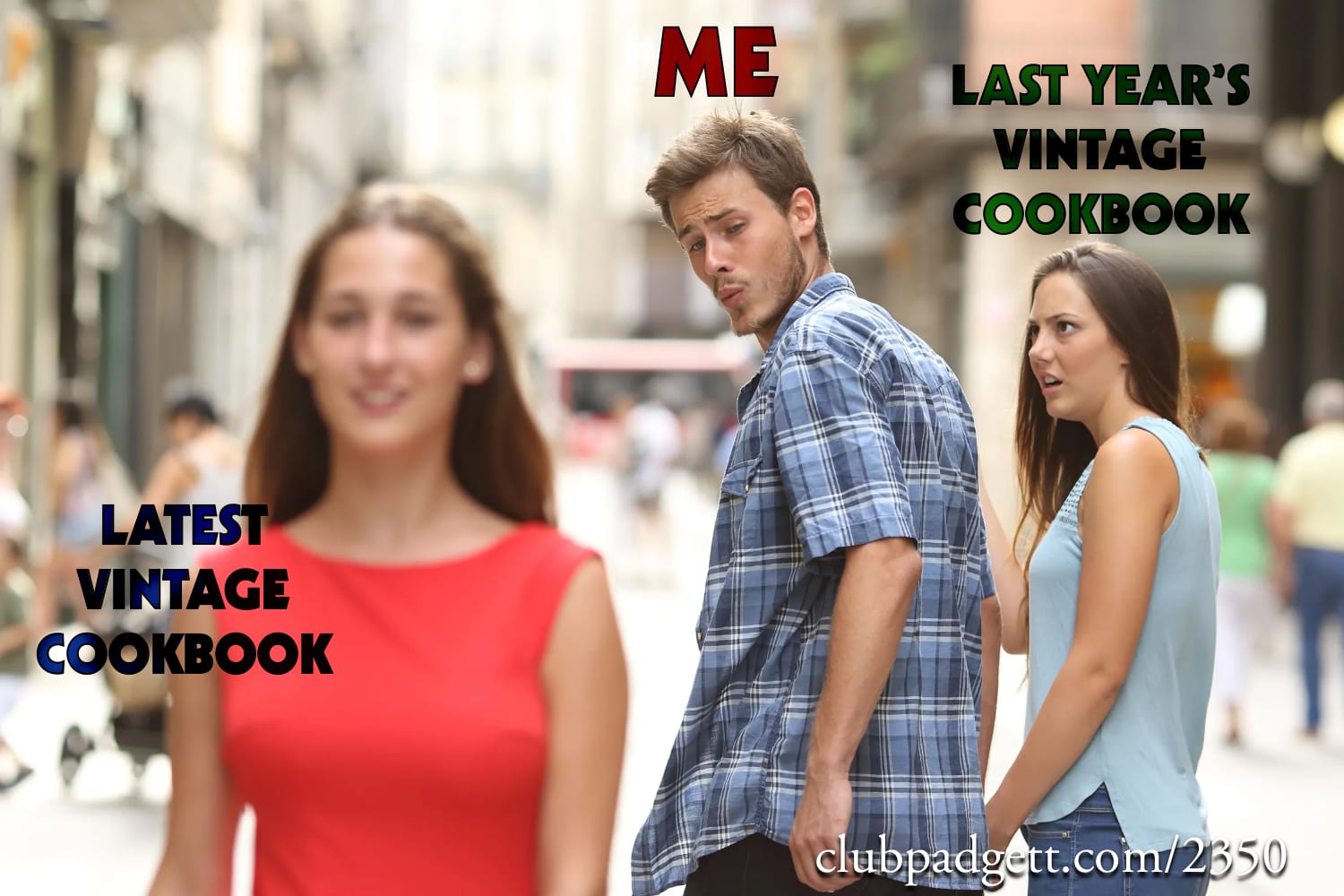
On December 28 of last year, I posted A 1950 recipe calendar for 2023 and wrote that:
I’m looking forward to trying a new recipe from this calendar each month come January.
I didn’t use as many of these recipes as I would have liked. Life kept intruding, and new cookbooks kept beckoning. But I did manage to try July’s Banana Cream Whip recipe well after the Fourth, August’s Date-Peanut Butter Filling for summer guests, November’s Cranberry Ice Box Pudding for Thanksgiving, and December’s Fruited Peanut Butter Rolls for Christmas.
I remade October’s Bacon-Corn Fondue over the holidays, as I planned to do, although I didn’t use ham this time.
Given how few recipes there are per month, I do wonder how often members of the Hope Lutheran community brought the same dishes to get-togethers! Fortunately, making these recipes 73 years later I didn’t have to worry about someone else bringing the same one.
Independence Day’s Banana Cream Whip is such a lovely and simple recipe, I’m surprised it’s not in the Chiquita Banana Recipe Book.

Banana Cream Whip
Servings: 4
Preparation Time: 1 hour
A 1950 recipe calendar for 2023
Hope Lutheran 1950 calendar of recipes (PDF File, 11.7 MB)Ingredients
- 1 cup mashed bananas (2-3 bananas)
- 1 tbsp lemon juice
- ¼ cup sugar
- ⅛ tsp salt
- ½ cup whipping cream, whipped
Steps
- Mix bananas, lemon juice, sugar and salt.
- Fold in whipped cream.
- Chill.
- Serve as is, with sliced fruit, or sprinkled with granola.
- May 17, 2023: Something fishy in the state of Wisconsin
-
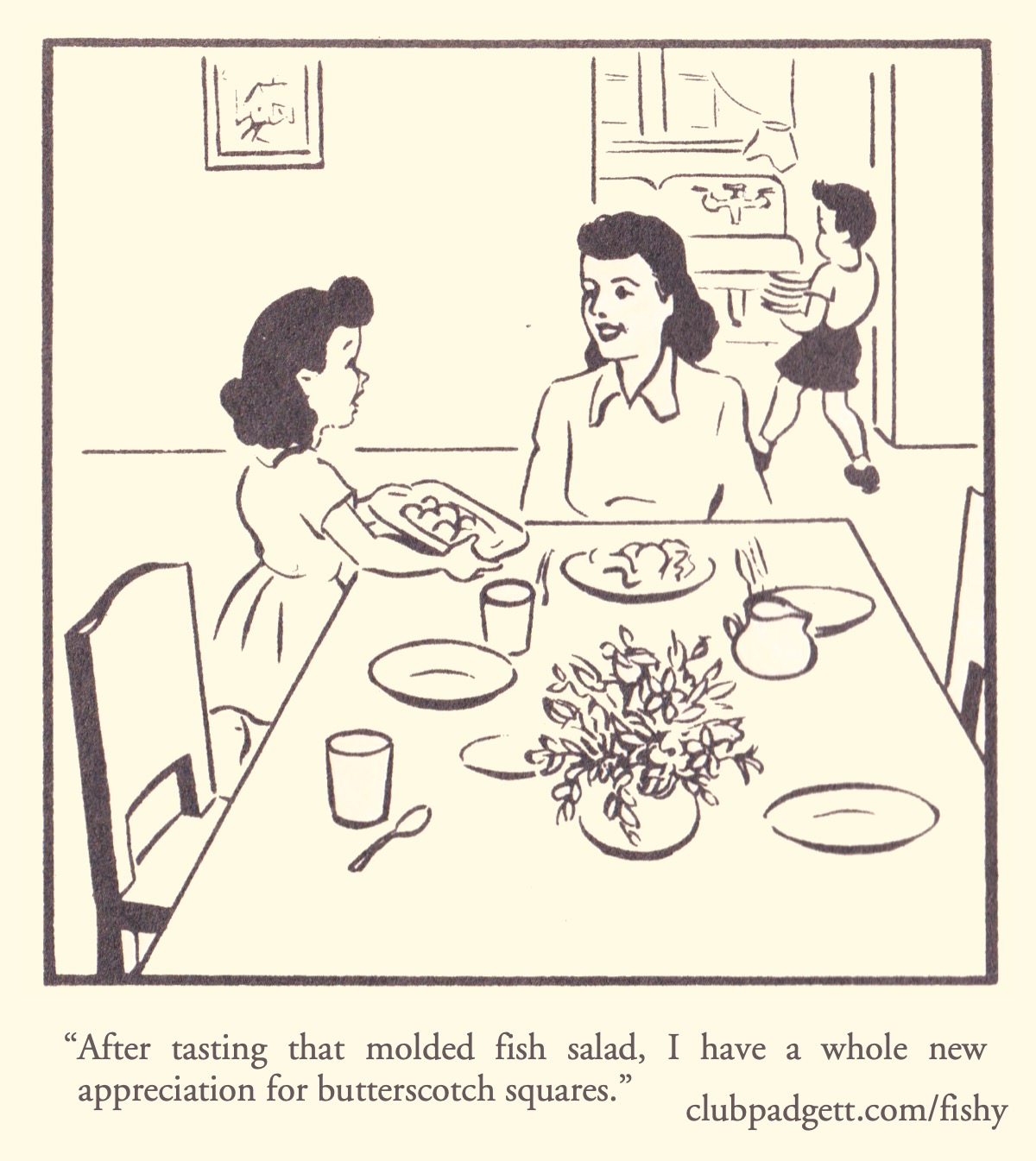
You and me both, mom.
The fish dishes continue into May in the Hope Lutheran 1950 calendar (PDF File, 11.7 MB). For April, I made the Oyster Stew and the Salmon Salad. For May, I made the Molded Fish Salad.
I was very pessimistic about the Molded Fish Salad, but the reality exceeded my wildest fears.
April’s fish recipes were very easy, tasty, and worth remembering. They were, like the Shrimp Spaghetti I wrote about in the parent post, meant to be made quickly and from canned ingredients. There are a lot of fish recipes in this calendar, mostly from cans. This is the first time I’ve used canned oysters, and the first time I’ve used canned salmon. I was pleasantly surprised by both.
The oyster stew and salmon salad were part of the “Easter season of celebration”. I had actually thought about making the Chocolate Marble Cake in April, but I have some other chocolate cakes I want to try more, and I also already had too many baked goods on my schedule.
Further, the Salmon Salad helped me use up two items in my refrigerator, half of a tiny jar of pimentos and the tiny bit remaining in a jar of my homemade India Relish from a 1981 Michigan cookbook.
You can see the butter in the oyster stew. It gives the milk and cream an almost cheese-like color. And of course you can taste it, too. This is a very rich stew for such a quick meal.
It also features a very old-school technique. When you’re done with the stew, you don’t just remove the bay leaf, you also remove the onion and parsley. Like the bay leaf, they’re used to flavor the soup, not to texture it. It’s a creamy soup whose only texture is its creaminess and the very buttery oysters.
I was pretty sure that, as long as the canned oysters were good the oyster stew would be good. I was less sure of the salmon salad. In fact, I really like salmon and was afraid of wasting some on a bad recipe. But as I said above, the recipe helped empty my fridge of two almost-empty jars. That was a very serendipitous coincidence.
- April 19, 2023: Hope Lutheran 1950 Lenten fish au gratin
-

I’m not necessarily going to cover every month in the 1950 calendar I posted just before the New Year. While I will be making a recipe from every month, I expect that some months won’t justify a post. For example, I wasn’t going to do a post for March’s calendar recipe. The fish au gratin I made was fine but I didn’t have enough to say about it to justify a post.
But there is something about it to justify an unfocused ramble. One of the interesting things about a cookbook that is also a calendar over half a century old is that it follows seasons that no longer exist.
In the Catholic Church, in 1950, abstinence lasted nearly the entire period of Lent, not merely Fridays.1 Easter in 1950 was the same date as this year in 2023 and that means that like this year, the entire month of March 1950 was Lent.2

A bottle of fine vintage mead… one year old, anyway, that has been in my fridge since I made it in early 2022.
From what I can tell, in the Catholic Church it wasn’t until 1962 that abstinence was relegated to Fridays3 I suspect there was something similar at Hope Lutheran as well, because every recipe in March was seafood. It was only when I started thinking about that that I decided to do this post.
Now, this calendar is not a Catholic calendar: Hope Lutheran is, obviously, Lutheran. Specifically, Missouri Synod Lutheran.
- February 22, 2023: 1950 Cherry Pudding Dessert
-
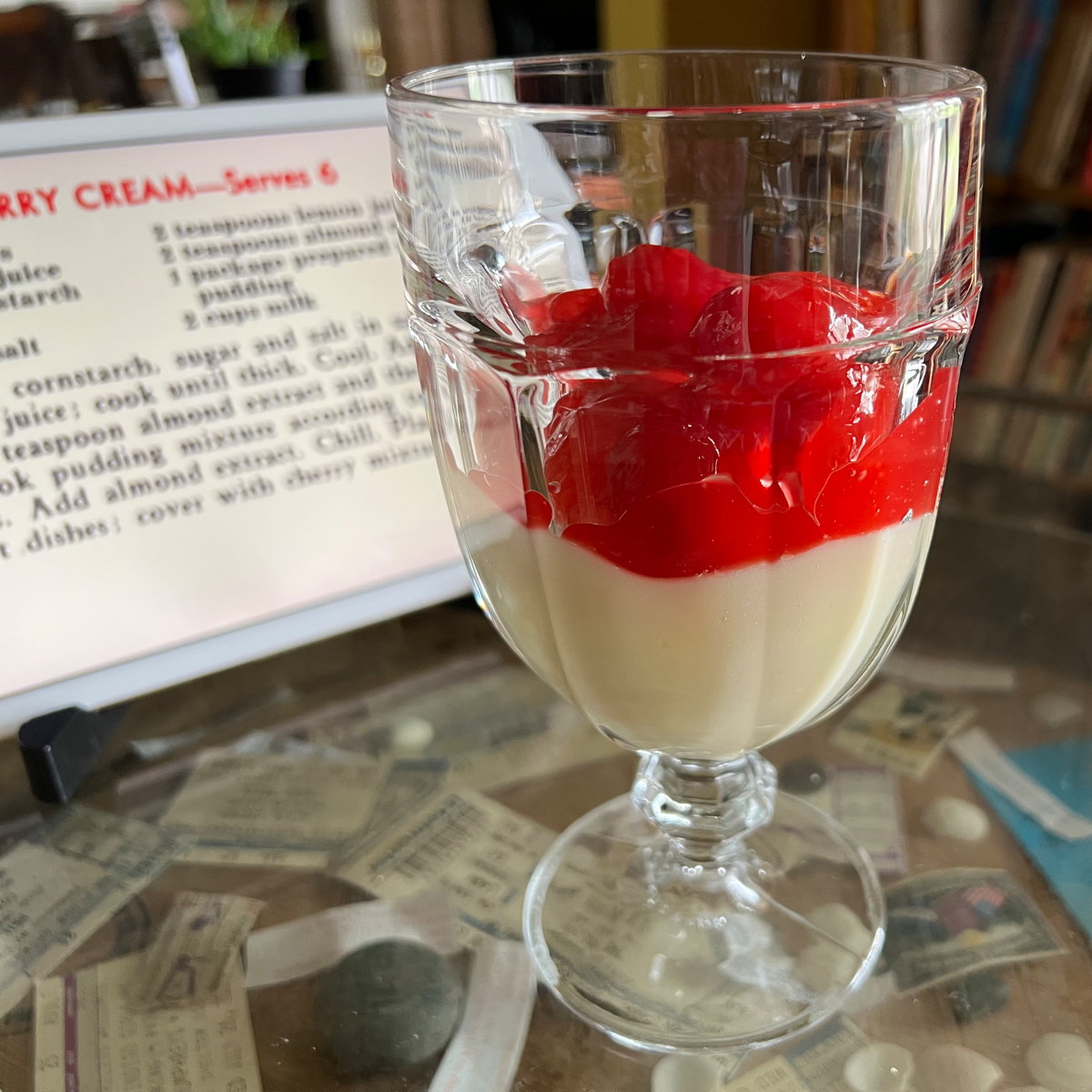
For February’s 1950 calendar recipe, I had planned to choose the Shrimp Spaghetti. But I found myself in a hurry and wanting something sweet, and realized that the Cherry Cream would give me an excuse to also make my favorite vanilla pudding. I still intend to try the Shrimp Spaghetti. It’s just such a Deplorable Gourmet combination of ingredients. But it’ll have to wait until later.
The Cherry Cream recipe calls for a package of vanilla pudding; if I’m reading it right, it assumes that you’re mixing the two cups of milk in the ingredient list with a package of powder. The milk isn’t called for anywhere else, and it’s listed after the “1 package prepared vanilla pudding”. The recipe then later refers to the prepared pudding as “custard” if I’m reading it right.
My favorite quick vanilla pudding recipe uses 2-½ cups of milk, so that’s what I used for the “custard” of this cherry pudding.
I’m not sure what the recipe list means by “cherries”. I’m assuming some sort of canned or preserved cherries, because the second item in the ingredient list is a cup of cherry juice. I’m guessing that the juice comes from the can or jar of cherries. I chose to use maraschino cherries, because I have a giant jar of them in the back of my fridge. I suspect that maraschino cherries are sweeter than what they meant, so I cut back on the sugar, from ¾ cup to about ⅓ cup. I probably could have cut back further, or even completely.
I also increased the lemon juice by half, to a full tablespoon. Partly to offset the sweetness, but also because I had a bowl of leftover lemon juice in the fridge and it turned out to be exactly a tablespoon. There didn’t seem much point in leaving a teaspoon of lemon juice in the fridge.
And as is often the case, I doubled the amount of almond extract in the cherry part of the mix, because I pulled the fact of almond extract from the instructions, and the amount from the ingredient list. Recipes that sum ingredients which get used in multiple parts of the instructions often cause me to mistakenly add the full amount from the list rather than the partial amount from the instructions. It doesn’t seem to have hurt it, probably, again, because the maraschino cherry juice is very sweet.
- February 8, 2023: January birthday veal from 1950
-

In A 1950 recipe calendar for 2023 I wrote that “I’m looking forward to trying a new recipe from this calendar each month come January.”
As New Year resolutions go, that’s not a difficult one. A little expensive. For January’s recipe, it came down to the Birthday White Cake or the Veal Steak Rolls; The cake looks very good, but I was already making a lot of baked goods from the El Molino Best cookbook, so I went with the Veal rolls.
Veal is not cheap nowadays, so I made a half recipe. A little under a pound of veal cutlets was about twelve dollars. January is a birthday month according to the calendar, and birthdays demand a special meal. A special meal justifies a little added cost.
I don’t know that veal cutlets are the same as the “veal steaks” called for in the recipe, but it was either cutlets or ground veal. Veal doesn’t seem to be as popular as it once was, either.
I don’t have garlic salt on hand, so I seasoned the veal with salt, pepper, and crushed garlic.
The recipe makes the interesting assumption that 2 pounds of veal steaks is the same number of pieces as a half pound of sliced ham. I didn’t think to measure it, but that seems about right. My just-under-a-pound of veal cutlets meant four cutlets; four slices of the sliced ham that I bought for this recipe (and for sandwiches from El Molino whole wheat bread) seems likely to have been about a quarter pound, perhaps a little less.
Had I gotten a full pound, that would have meant another cutlet. My guess is that the recipe is meant to produce ten, or maybe twelve, rolls.
You’ll need to reinforce all of the holes if you are a rebel who ignores the advice not to tear off previous months.
↑You can also buy hole reinforcers but then you’ll have a bunch of hole reinforcers left over.
↑Apropos of nothing, in 1950 Christmas Eve had a full moon. In 2023, the full moon isn’t scheduled until December 26.
↑
downloads
- 2023 Old Recipe Calendar (PDF File, 9.4 MB)
- A 1950 recipe calendar repurposed for printing and hanging in 2023.
- The Deplorable Index
- The greatest movie review of all time… and it’s a cookbook. A cookbook!
- Hope Lutheran 1950 calendar of recipes (PDF File, 11.7 MB)
- A calendar of recipes for 1950, courtesy Hope Lutheran Church of Milwaukee.
Christmas
- 2023 Phases of the Moon
- “Prepared by Griffith Observatory using USNO MICA software and NASA/JPL Horizons Web Portal”
Hallowe’en
- Halloween: Origins, Meaning & Traditions
- “By the 1950s, town leaders had successfully limited vandalism and Halloween had evolved into a holiday directed mainly at the young… Between 1920 and 1950, the centuries-old practice of trick-or-treating was also revived [as] a relatively inexpensive way for an entire community to share the Halloween celebration.”
- Trick-or-treating at Wikipedia
- “Trick-or-treating was depicted in the Peanuts comic strip in 1951. The custom had become firmly established in popular culture by 1952, when Walt Disney portrayed it in the cartoon Trick or Treat, and Ozzie and Harriet were besieged by trick-or-treaters on an episode of their television show.”
Milwaukee
- Hope Lutheran Church, Milwaukee
- “We are children of God committed to teaching His Word in order to strengthen our connection to Christ, Congregation, and Community.”
- Kaestner Funeral Home Collection
- “The collection consists of the Kaestner Funeral Home’s funeral records and ledger for 1931. The ledger includes helpful genealogical information (if known) about the deceased, including the individual’s place of birth, age, occupation, the names (including mother’s maiden name) of both parents and their nativity.”
More 2023
- My Year in Food: 2023
- From Italy to the Ukraine—some of it real, and some through cookbooks—this has been a great year for food.
- My Year in Books: 2023
- It’s been a slower year in books than previous ones, but it was still a year of fantasy in the past, in the future, and across time, as well as an unplanned foray into people doing the impossible and changing the world.
More calendars
- Hope Lutheran 1950 Lenten fish au gratin
- One of the interesting things about old calendars that are also something else—such as a cookbook—is that they follow seasons that no longer exist.
- Simple .ics iCalendar file creator
- A simple Perl script to create an ics file from a human-readable text of events.
More cookbooks
- My Year in Food: 2024
- From Italy, to San Diego, to Michigan, and many points in between; and from 1876 up to 2024 with stops in the 1920s, this has been a great food year.
- Mrs. Winslow’s Domestic Receipt Book for 1876
- If this is what people were eating in 1876, they were eating very well. From coconut pie to molasses gingerbread to tomato jam, these are great recipes—albeit requiring some serious interpretation.
- Stoy Soy Flour: Miracle Protein for World War II
- To replace protein lost by rationing, add the concentrated protein of Stoy’s soy flour to your baked goods and other dishes!
- Refrigerator Revolution Revisited: 1942 Cold Cooking
- Iceless refrigeration had come a long way in the fourteen years since Frigidaire Recipes. And so had gelatin!
- Rumford Recipes Sliding Cookbooks
- One of the most interesting experiments in early twentieth century promotional baking pamphlets is this pair of sliding recipe cards from Rumford.
- 68 more pages with the topic cookbooks, and other related pages
More fifties
- Looking back over 1950 in vintage cooking
- While I didn’t make my goal of trying a recipe every month in the month it was meant for, following this calendar through 2023 was an interesting experience and provided some very good food.
- El Molino Best: Whole grains in 1953
- El Molino Mills of Alhambra, California, published a fascinating whole grain cookbook in 1953.
- Something fishy in the state of Wisconsin
- Fish soup, fish salad, and fish gelatin. These are very fifties recipes—for better and for worse. Very worse.
- 1950 Cherry Pudding Dessert
- A vanilla-almond custard covered with a thick cherry sauce, from a 1950 recipe calendar.
- January birthday veal from 1950
- The Veal Rolls from the 1950 recipe calendar of Hope Lutheran Church in Chicago.


